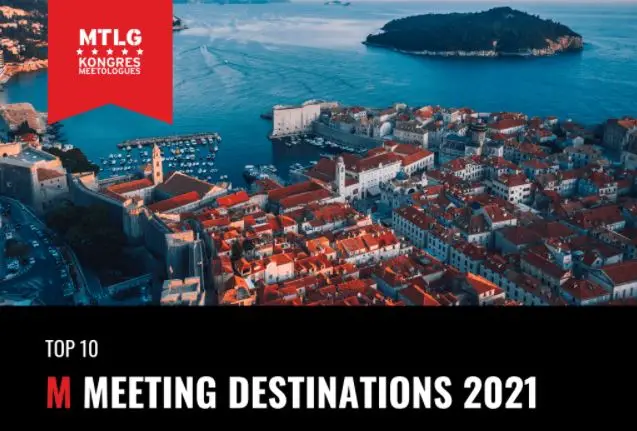After the devastation of the pandemic on the congress industry in 2020, events are slowly getting back to a semblance of what they were pre-pandemic, although there is obviously a long way to go.
But it seems that Croatia is more than ready to meet the demand. The 2021 Meeetings Experience Index (MTLG – MEETAOLOGUE) was published recently, a comprehensive analysis of 118 congress destinations in ‘New Europe’, nad there was a very strong showing by a number of Croaita’s congress destinations.
MTLG defines New Europe as:
The answer to this question is something of an unsolved conundrum. A clear definition of New Europe doesn’t exist, the most general definition being that these are the countries of Eastern Europe that were once behind the Iron Curtain. Technically, this means 24 countries of Eastern Europe, adding Greece and Turkey to them. In our Editorial, we include the fresh, energetic and lesser-known European destinations in New Europe.
There was a particularly good showing for Zagreb and Dubrovnik. Zagreb was named 5th best destination overall, as well as third in the category of large congress destinations, with Dubrovnik coming in 7th.
It seems that Croatia’s niche is perhaps in the medium sized category, where no less than 4 Croatian congress destinations featured. Dubrovnik topped the list, followed by Split in second, Opatija in 5th, Rovinj in 7th, and Sibenik in 8th.
And there was good news for the island of Hvar as well, which came second in the category of small congress destination.
This is what they had to say about Zagreb:
A great congress future awaits Zagreb. It is well established in the international congress market and in addition to Ljubljana and Belgrade, it represents the future backbone of the continental meetings industry of the region. All three cities are progressing steadily on the charts of developed meetings destinations; the final breakthrough of the entire region is intertwined and dependent on the marketing of major regional congress cities in the international market.
About Dubrovnik:
Dubrovnik is the flagship of regional tourism and is commonly the first association of meetings organizers we meet daily. It is the closest in the region to renowned Mediterranean convention destinations Cannes and Monte Carlo. The modern and well-equipped centres at hotels such as Dubrovnik Palace, Excelsior, Bellevue, Grand Villa Argentina, Importanne Resort, Dubrovnik President, Valamar Lacroma and Radisson Blue are all great for hosting a variety of events. Well-developed is the entire conference infrastructure including destination management and creative agency scene. The city is safe and one of the tourist icons of the Adriatic and justifiably the most painted tourist skyline with unprecedented experiential diversity for conference guests.
About Split:
Among the Adriatic congress destinations Split has become serious competition to Dubrovnik in the last years. The main disadvantages of the destination are bad cooperation between the service providers, lack of air traffic connections to key markets and not enough destination marketing. If Split gets a real convention centre in the future, it could become one of the leading congress destinations in the Mediterranean. New and excellent hotel capacities, good road connections to Europe and wonderful surroundings, with islands offering numerous incentive programme opportunities, all bolster this proposition. Split is still one of the most unexploited congress destinations in the Mediterranean.
About Hvar:
None of the more than 1,000 Croatian islands has such karma and recognition as Hvar. Definitely, a “must” Croatian destination, right behind Dubrovnik. Distance from the mainland gives it a touch of boutique smallness. On the beauty of the island, reminiscent of the Garden of Eden, there is no point in wasting words, since there is no shortage of various urban legends and superlatives. Among other things, it used to be called Austrian Madeira. In Hvar, the urban has been coexisting with the rural for centuries.
About Opatija:
Opatija is without a doubt the ultimate meetings destination. Why? Because few destinations provide such a rich assortment of luxury accommodation in such a small area, whilst Opatija provides 33 hotels offering over 2700 rooms and more than 50 meeting and conference halls along the 3 km of the coastline. At the beginning and the end of the Opatija Riviera, there are two boutique hotels that contribute to the exclusivity of Opatija.
About Rovinj:
If at the destination you have owners who have clear goals and who look at congress tourism strategically, then in a short time you can do a lot. It is possible to revitalize the old factory premises and build a superior conference hotel. Maistra in Rovinj has undoubtedly left its mark. Taking into consideration the geographical location of Rovinj as one of the closest Mediterranean congress destinations for Central and Western Europe, the future of this industry is guaranteed. Missing is only a convention bureau, which would know how to step out of corporate governance of the destination and would be able to serve as attorney of the meetings industry. Otherwise, forecasts of mayor Sponza that Rovinj will be more exclusive than Dubrovnik, can be realized.
About Sibenik:
Šibenik very rarely raises any association with the meeting industry. In the process of transition from an industrial city into a tourist destination, it has not yet asserted its image among competing cities. Despite this, it is a fact that it has excellent conditions and is somehow considered to be a hidden jewel of the Croatian congress offer. For ease of accessibility, it may be a suitable location for small association conferences as well as a variety of incentive programmes.
Regarding the methodology, Kongres Magazine explained the criteria assessed:
The Meeting Experience Index is one of the most complex destination evaluations that is not only based on the number of congress events but delves deeper analytically. The methodology addresses all key meetings industry segments and thus all key MICE products. 75 evaluation criteria are used to determine the final destination score. That is why the Meeting Experience Index has become the bedrock for selecting destinations for meeting planners.
All destinations are evaluated based on fieldwork and thorough research of individual criteria with the objective to come as close as possible to the real situation. Moreover, the editorial board of Kongres Magazine strives to present up-to-date information that is objective and transparent. Each year, the destination scores are revised and corrected with timely information.
You can see all the results on Kongres Magazine’s website.









